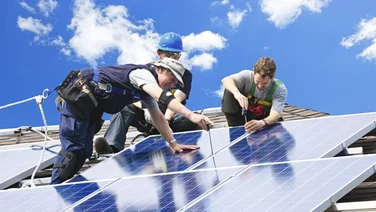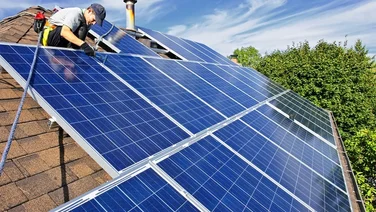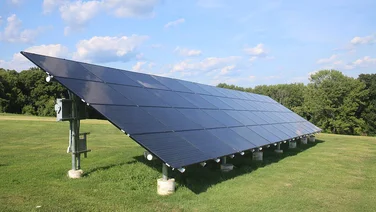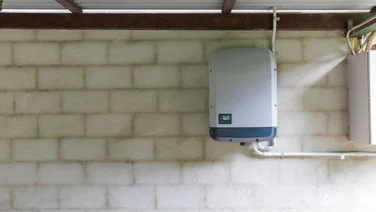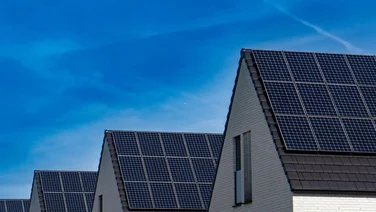✔ Solar thermal panels can save you £1,350 over their lifetime
✔ You’ll also reduce your carbon footprint by 6.6 tonnes of CO2, on average
✔ A typical solar thermal system costs £4,000
Solar thermal panels are a renewable way to save money on your energy bills, as it can supply half of your water-heating needs. Solar water heaters can help cut carbon and save money.
Below is everything you need to know about going thermal, from how the panels work to how much return on your investment you’ll receive.
If you want to find out whether solar panels would be worth it for you, fill in this form to receive free quotes from trusted suppliers.
Where do you want to install solar panels?
Get started
What are solar thermal panels?
Solar thermal panels sit on your home’s roof, absorb the sun’s rays, and turn them into hot water for your home.
They’re the water-heating equivalent of solar PV panels, and are around the same size. Thermal panels take the infrared part of sunlight and convert it into heat. This warms up the liquid in the panels, which is usually a mixture of water and glycol.
This hot fluid circulates through your pipes, constantly heating up cold water as it’s supplied from the mains. This process will fill your hot water cylinder, so you’ll have a plentiful supply when it comes to showering, washing clothes, or anything else.
Solar thermal can also be used to operated heating systems, such as solar-powered wet underfloor heating.
Thankfully, solar thermal panels can be added to conventional boiler or immersion heater systems with very little effort.
Solar thermal panels are also generally cheaper than photovoltaic (PV) panels.
There are also solar PV panels that generate heat as well as electricity. These are called hybrid solar panels. You can find out more by going to our page.
Do solar thermal panels work in the UK?
Solar thermal panels absolutely work in the UK – and don’t worry about cloudy skies. Thermal panels can function even when the sky is overcast, as the sun’s radiation passes through clouds just fine.
During the summer, your solar thermal panels should supply about 90% of the hot water you need, though this will drop to around 25% during winter, according to the Energy Saving Trust (EST).
The positive but limited nature of thermal panels means you’ll need an additional source of hot water to pick up the slack when the sun isn’t constantly shining.
A boiler or immersion heater should do the job just fine, and the additional solar energy will simultaneously save you money and help you fight climate change.
Considering 82% of people have adjusted their behaviour at home in the past 12 months to save on energy bills, according to our National Home Energy Survey, solar thermal panels are only set to increase in popularity.
Want to learn more? Check out our helpful guide Can Solar Panels Heat A House In The UK?
Where do you want to install solar panels?
Get startedHow much do solar thermal panels cost?
A solar thermal panel system will usually cost between £3,000 and £5,000 for a three-bedroom house.
And once this expense is out of the way, you can start cutting your bills and carbon footprint by using an endless supply of sunshine.
That’s not the case with traditional heating systems such as gas boilers, which just act as a carbon-emitting money pit until they break down.
What’s the return on investment from solar thermal?
A typical homeowner will pay £4,000 for a solar thermal panel system, and recoup £1,350 of that expense over the next 25 years – but you won’t break even with a gas boiler either. Let’s dive into how we worked out these figures.
Solar thermal panels will cut your hot water bills by 50% on average, according to government research.
So a typical household expends 1,460 kWh per year on hot water – but your solar thermal panels can supply half of this figure.
With the gas price currently at 10.3p per kWh, those of you with a gas boiler could save £75 per year by supplying 730 kWh of your hot water with clean, sun-fuelled energy.
Of course, you can increase this saving by installing more panels – with each square metre saving you more.
You’ll also cut 6.6 tonnes of greenhouse gases from your carbon footprint over this period, which is a substantial amount.
The government’s Renewable Heat Incentive (RHI) would’ve increased solar thermal panel owners’ savings, but unfortunately the scheme ended in March 2022.
Are there any government grants for solar thermal?
From April 2022 onwards, there won’t be any government grants available for solar thermal systems.
The Renewable Heat Incentive was the most prominent government grant for solar thermal systems in recent times.
As we mentioned, this scheme offered owners 10.92p per kWh they produced with solar thermal heating, biomass boilers, or heat pumps – but it’s been cancelled, and won’t exist past March 2022.
Its replacement, the Boiler Upgrade Scheme, doesn’t provide any discounts or payments for households that get solar thermal systems.
The government has said the scheme is “targeted at systems that maximise carbon savings,” and therefore, qualification is dependent on whether a technology is “capable of meeting the full space and water heating demands of the property.”
The only good news is that installing solar thermal heating at your property won’t disqualify you from receiving a grant for a heat pump or biomass boiler.
The £2 billion Green Homes Grant was created to cut the cost of installing renewable technologies like solar thermal panels by as much as two-thirds – but it fell flat, and was cancelled in March 2021.
How popular is solar thermal in the UK?
In 2020, 1,569 m² of solar thermal infrastructure was installed in the UK, according to the International Energy Agency (IEA).
This was the ninth consecutive year that solar thermal installations declined in the country, but there’s a very good reason for that trend: the Feed-In Tariff.
From April 2010 until March 2019, anyone who installed solar panels and signed up to this government scheme received money for generating solar electricity.
These payments were particularly generous at first, resulting in a seismic shift from solar thermal to solar PV among UK homeowners.
This led to solar thermal installations nosediving from 90,000 m² in 2010 to 1.7% of that total in 2020 – but things are looking up now for the solar thermal industry.
The end of the Feed-In Tariff has levelled the playing field, and the IEA expects solar thermal installations to rise once more.
Summary
Getting a solar thermal system is a wonderful way to reduce your fossil fuel usage in favour of using sunlight to heat half of your hot water supply.
You almost certainly won’t break even, but you also won’t break even on a new gas boiler. At least this way, you can help reduce the effects of climate change.
If you want to see how much solar panels would cost for your home, just fill in this form to receive free quotes from our trusted suppliers.


